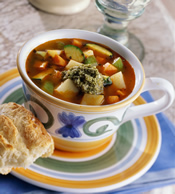This page has been archived and is being provided for reference purposes only. The page is no longer being updated, and therefore, links on the page may be invalid.
|
|
Blazer Russet Potato Wins Top Reviews
By Marcia WoodAugust 8, 2006
Versatile and delicious, Blazer Russet potato is one of the newest graduates of the potato-breeding program of university and Agricultural Research Service scientists in the Pacific and Intermountain West. This potato is well-suited for fresh-market sale or for potato processors to make into frozen potato products.
The oblong, medium-to-large Blazer Russet tubers each average about 7 to 8 ounces. They have the characteristic light netting, called russeting, on their brown-to-tan skin, with firm, cream-white or white flesh inside.
Potato growers and processors in western states worked with ARS potato breeders and their University of Idaho, Washington State University and Oregon State University colleagues to put the tuber through nearly two decades of rigorous laboratory, field and test-kitchen scrutiny before the decision was made in December 2005 to make this experimental potato a named variety. Until that time, Blazer Russet was known simply by its breeder number, A8893-1.
According to ARS potato breeder and plant geneticist Richard G. Novy, potato processors are viewing Blazer Russet as a promising replacement for Shepody, a potato that is widely grown in the United States.
Both Blazer Russet and Shepody are ready to harvest earlier than other leading potatoes, meaning that the two russets can replenish dwindling supplies of potatoes remaining in cold storage from the previous harvest. But Blazer Russet provides higher yields of premium potatoes, known as U.S. No. 1, than Shepody, according to Novy. He is based at the ARS Small Grains and Potato Germplasm Research Unit in Aberdeen, Idaho.
ARS scientists Dennis L. Corsini and Joseph J. Pavek, both now retired, selected the parent potatoes for today's Blazer Russet in 1988. In tests that followed, Blazer Russet plants typically outproduced even America's potato idol, Russet Burbank.
Blazer Russet is one of a series of superior potatoes from a regional collaboration among ARS and university scientists known as the Northwest Potato Variety Development Program.
ARS is the U.S. Department of Agriculture's chief scientific research agency.

